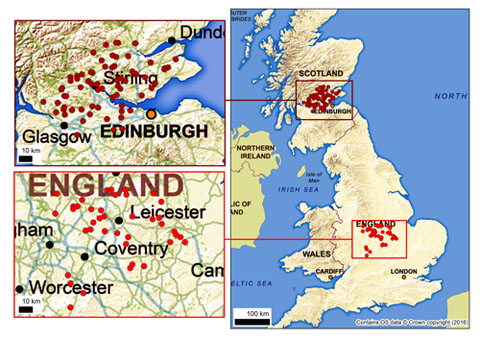Summary
Summary
WrEN is a long-term, large-scale ‘natural experiment’ which is studying biodiversity in a chronosequence of woodlands created in UK landscapes over the past 160 years.
This project aims to test the relative impact of different site and landscape attributes on key species groups, ranging from plants, lichens and insects to small mammals, bats and birds.
Results from the WrEN project will help to develop recommendations on the design of future site and landscape conservation strategies for a range of woodland species.
Research objectives
WrEN is aiming to understand the role of specific site and landscape-scale attributes on multiple species groups, these include:
| Site-scale attributes | Landscape-scale attributes |
| (i) Patch size | (iv) amount of surrounding habitat |
| (ii) Patch quality | (v) degree of spatial isolation |
| (iii) Patch age | (vi) nature of the surrounding matrix |
WrEN will allow us to answer a number of important research, policy and practice questions, including:
- What is the relative impact of each site and landscape attribute on different species?
- What is the relative importance of site versus landscape on different species?
- What is the time lag between habitat creation and species’ responses?
- What types of woodland should we create in the future, and where should they be located in the landscape?
Results so far
- A journal paper has been published on the existing evidence base:
Humphrey, J.W., Watts, K., Fuentes-Montemayor, E., Macgregor, N.A., Peace, A.J. & Park, K.J. (2015) What can studies of woodland fragmentation and creation tell us about ecological networks? A literature review and synthesis. Landscape Ecology, 30, 21–50. https://link.springer.com/article/10.1007/s10980-014-0107-y - A journal paper has been published describing the rational and process of creating the WrEN project:
Watts, K., Fuentes-Montemayor, E., Macgregor, N.A., Peredo-Alvarez, V., Ferryman, M., Bellamy, C., Brown, N. & Park, K.J. (2016) Using historical woodland creation to construct a long-term, large-scale natural experiment: the WrEN project. Ecology and Evolution, 6, 3012–3025. https://onlinelibrary.wiley.com/doi/full/10.1002/ece3.2066 - Fuentes Montemayor, E., Watts, K., Macgregor, N.A., Lopez‐Gallego, Z. & Park, K. (2017) Species mobility and landscape context determine the importance of local and landscape‐level attributes. Ecological Applications.
- Fuller, L., Fuentes-Montemayor, E., Watts, K., Macgregor, N.A., Bitenc, K. & Park, K.J. (2018) Local-scale attributes determine the suitability of woodland creation sites for Diptera (ed J Müller). Journal of Applied Ecology, 55, 1173–1184.
- Whytock, R.C., Fuentes-Montemayor, E., Watts, K., Macgregor, N.A., Williams, L. & Park, K.J. (2018) Context-dependent colonization of terrestrial habitat ‘islands’ by a long-distance migrant bird. Proceedings of the Royal Society B: Biological Sciences, 285, 20181490.
- Whytock, R.C., Fuentes-Montemayor, E., Watts, K., Barbosa De Andrade, P., Whytock, R.T., French, P., Macgregor, N.A. & Park, K.J. (2018) Bird-community responses to habitat creation in a long-term, large-scale natural experiment. Conservation Biology, 32, 345–354.
- Ashwood, F., Watts, K., Park, K., Fuentes‐Montemayor, E., Benham, S. & Vanguelova, E.I. (2019) Woodland restoration on agricultural land: long‐term impacts on soil quality. Restoration Ecology, rec.13003.
- Fuentes-Montemayor, E., Ferryman, M., Watts, K., Macgregor, N.A., Hambly, N., Brennan, S., Coxon, R., Langridge, H. & Park, K. (2019) Small mammal responses to long-term, large-scale woodland creation: the influence of local habitat characteristics and landscape context. Ecological Applications.
- The WrEN team have so far selected 106 woodland sites (67 in Scotland and 39 in England)

- Sites were specifically selected to cover the widest possible range of key site and landscape attributes, currently consisting of:
Site-scale attributes
-Patch size (0.5 – 32ha)
-Patch age (10 to 160 years)
Landscape-scale attributes
-amount of surrounding habitat (ranging from 1 to 17% within a 3 km buffer)
-degree of spatial isolation (between 7 and 1573 m from the nearest wood)
We have conducted numerous habitat and species surveys. We are still processing data but so far we have recorded:
-vascular plants – 177 species; lichens – 172 species, bryophytes – 77 species
-small mammals – 15,000 trap nights, 1700 individuals, 4 species
-bats – 1700 hours of acoustic recording, 57,000 bat passes, 6 species/genera
-birds – 8000 records of 59 species
-spiders – 4000 individuals, 103 species
-beetles – 30,000 individuals, 130 species
-craneflies – 5000 individuals, 104 species
-hoverflies – 1300 individuals, 63 species. - We have recently added 27 ancient woodlands to the WrEN project to act as comparative woodland reference sites.
- We are also looking into the development of soils along a continuum from agricultural fields, secondary WrEN sites to ancient woodland with colleagues from FR with funding from the Woodland Trust
- We are currently analysing and writing up much of the WrEN data and have a number of papers in review and nearing publication – more results to follow very soon.
Status
WrEN started in 2013 as a collaborative project between Forest Research, University of Stirling and Natural England. Many people have contributed to ideas, organisation, data collection and analysis. Work within the WrEN project is ongoing and subject to funding.
Related Resources
Regular updates and development of the WrEN project can also be found at:
Contact
Funders and partners
WrEN is a collaborative project between Forest Research, University of Stirling and Natural England. It has been developed with funding from many sources including: Forestry Commission GB; Forestry Commission Scotland; Forestry Commission England; University of Stirling; Natural England; Defra; Natural Environmental Research Council; Scottish Natural Heritage; The National Forest; Woodland Trust; and the company Tarmac.
Forestry Commission policy
Challenges from the changing physical environment require continuing research to develop resilience and robustness of British woodland. Capacity for resilience is critical not only within our woodlands but also at a landscape scale. Our considerable capability in modelling at landscape scale must now be strongly linked to other UK and European research to address such problems as spatial planning, habitat fragmentation, gene flow, and dispersal and colonisation of species – both desirable and undesirable.
The restoration of natural and semi-natural habitats, and their associated species, is a major policy objective across the world stimulated by the Convention on Biological Diversity. The desirability of restoration is strongly advocated in EU and British environmental policies, including the UK Biodiversity Action Plan, the EU Habitats Directive and the EU Forestry Strategy. The Forestry Commission was a co-founder of the Global Partnership on Forest Landscape Restoration. Delivering effective restoration is not straightforward and requires co-ordinated research by a wide range of agencies on techniques for restoring threatened habitats that have been inappropriately managed. We will continue to play our part in research directed at conservation and restoration.
